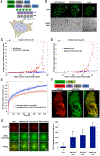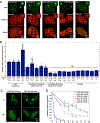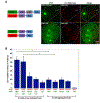Imaging dynamic and selective low-complexity domain interactions that control gene transcription
- PMID: 29930090
- PMCID: PMC6961784
- DOI: 10.1126/science.aar2555
Imaging dynamic and selective low-complexity domain interactions that control gene transcription
Abstract
Many eukaryotic transcription factors (TFs) contain intrinsically disordered low-complexity sequence domains (LCDs), but how these LCDs drive transactivation remains unclear. We used live-cell single-molecule imaging to reveal that TF LCDs form local high-concentration interaction hubs at synthetic and endogenous genomic loci. TF LCD hubs stabilize DNA binding, recruit RNA polymerase II (RNA Pol II), and activate transcription. LCD-LCD interactions within hubs are highly dynamic, display selectivity with binding partners, and are differentially sensitive to disruption by hexanediols. Under physiological conditions, rapid and reversible LCD-LCD interactions occur between TFs and the RNA Pol II machinery without detectable phase separation. Our findings reveal fundamental mechanisms underpinning transcriptional control and suggest a framework for developing single-molecule imaging screens for drugs targeting gene regulatory interactions implicated in disease.
Copyright © 2018 The Authors, some rights reserved; exclusive licensee American Association for the Advancement of Science. No claim to original U.S. Government Works.
Conflict of interest statement
Figures






Comment in
-
Concentrating on intrinsic disorder.Nat Rev Mol Cell Biol. 2018 Sep;19(9):544. doi: 10.1038/s41580-018-0039-5. Nat Rev Mol Cell Biol. 2018. PMID: 29993031 No abstract available.
-
Concentrating on intrinsic disorder.Nat Rev Genet. 2018 Sep;19(9):534. doi: 10.1038/s41576-018-0037-7. Nat Rev Genet. 2018. PMID: 30013225 No abstract available.
-
Dynamic condensates activate transcription.Science. 2018 Jul 27;361(6400):329-330. doi: 10.1126/science.aau4795. Science. 2018. PMID: 30049863 No abstract available.
References
Publication types
MeSH terms
Substances
Grants and funding
LinkOut - more resources
Full Text Sources
Other Literature Sources
Miscellaneous

